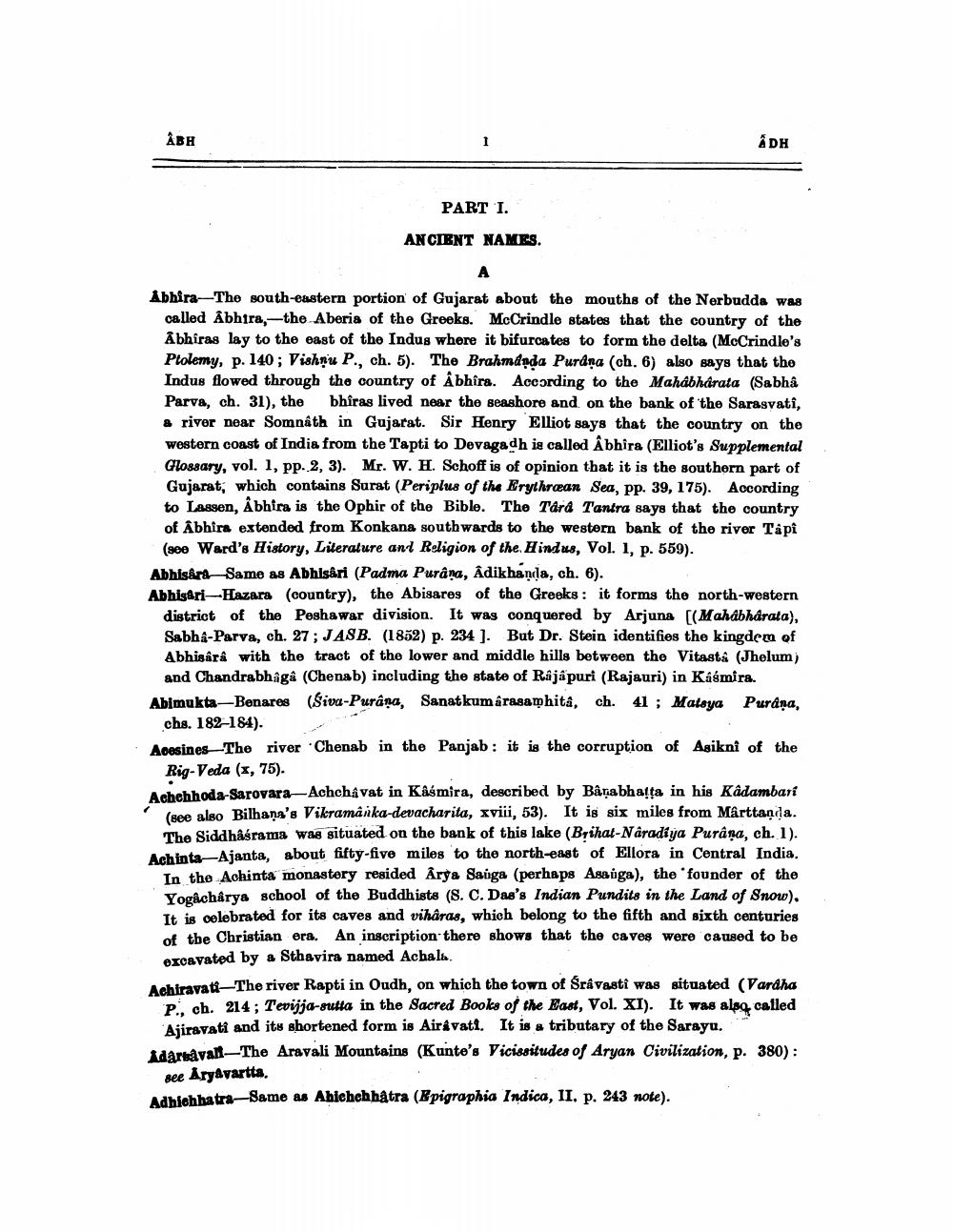________________
ABH
PART I.
ANCIENT NAMES.
ADH
A
Abhira-The south-eastern portion of Gujarat about the mouths of the Nerbudda was called Abhira, the Aberia of the Greeks. McCrindle states that the country of the Abhiras lay to the east of the Indus where it bifurcates to form the delta (McCrindle's Ptolemy, p. 140; Vishnu P., ch. 5). The Brahmanda Purana (ch. 6) also says that the Indus flowed through the country of Abhira. According to the Mahabharata (Sabhâ Parva, ch. 31), the bhîras lived near the seashore and on the bank of the Sarasvati, a river near Somnath in Gujarat. Sir Henry Elliot says that the country on the western coast of India from the Tapti to Devagadh is called Abhira (Elliot's Supplemental Glossary, vol. 1, pp. 2, 3). Mr. W. H. Schoff is of opinion that it is the southern part of Gujarat, which contains Surat (Periplus of the Erythraean Sea, pp. 39, 175). According to Lassen, Abhira is the Ophir of the Bible. The Târd Tantra says that the country of Abhira extended from Konkana southwards to the western bank of the river Tâpî (see Ward's History, Literature and Religion of the Hindus, Vol. 1, p. 559). Abhisara Same as Abhisâri (Padma Purana, Adikhanda, ch. 6). Abhisari-Hazara (country), the Abisares of the Greeks: it forms the north-western district of the Peshawar division. It was conquered by Arjuna [(Mahabharata), Sabhâ-Parva, ch. 27; JASB. (1852) p. 234]. But Dr. Stein identifies the kingdem of Abhisârâ with the tract of the lower and middle hills between the Vitasta (Jhelum) and Chandrabhaga (Chenab) including the state of Rajapuri (Rajauri) in Kasmira. Abimukta-Benares (Siva-Purana, Sanatkumarasam hitâ, ch. 41; Matsya Purana,
chs. 182-184).
Acesines The river Chenab in the Panjab: it is the corruption of Asikni of the Rig-Veda (x, 75).
Achchhoda-Sarovara-Achchávat in Kâśmira, described by Bârabhatta in his Kâdambari (see also Bilhana's Vikramânka-devacharita, xviii, 53). It is six miles from Marttaṇḍa. The Siddhâśrama was situated on the bank of this lake (Brihat-Nâradiya Purâna, ch. 1). Achinta Ajanta, about fifty-five miles to the north-east of Ellora in Central India. In the Achinta monastery resided Arya Sauga (perhaps Asaiga), the founder of the Yogacharya school of the Buddhists (S. C. Das's Indian Pundits in the Land of Snow). It is celebrated for its caves and vihâras, which belong to the fifth and sixth centuries of the Christian era. An inscription there shows that the caves were caused to be excavated by a Sthavira named Achala.
Achiravati-The river Rapti in Oudh, on which the town of Sravasti was situated (Vardha P., ch. 214; Tevijja-sutta in the Sacred Books of the East, Vol. XI). It was also called Ajiravati and its shortened form is Airavati. It is a tributary of the Sarayu. Adarsavali-The Aravali Mountains (Kunte's Vicissitudes of Aryan Civilization, p. 380): see Aryavartia
Adhichhatra-Same as Ahichchhatra (Epigraphia Indica, II. p. 243 note).




